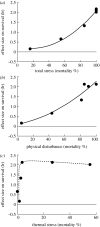Testing the facilitation-competition paradigm under the stress-gradient hypothesis: decoupling multiple stress factors
- PMID: 17686725
- PMCID: PMC2274984
- DOI: 10.1098/rspb.2007.0871
Testing the facilitation-competition paradigm under the stress-gradient hypothesis: decoupling multiple stress factors
Abstract
While the facilitation-competition paradigm under the stress-gradient hypothesis has received recent attention, its rigorous testing is yet to be explored. Most of the studies have considered a switch in the net interactions from competition to facilitation with increasing environmental stress as primary evidence supporting the hypothesis, though few studies examined changes in interaction along a full range of a stress gradient. Here, we have conceptualized possible variations in the patterns of change in interaction strength along such gradient. Based on this, we empirically evaluated the temporal shift in the interaction between two marine sessile animals, goose barnacles (Capitulum mitella) and mussels (Septifer virgatus), under multiple stress factors. The net effect of goose barnacles on mussel survivorship was positively related to the total stress gradient encompassing two stress factors, physical disturbance and thermal stress, while no negative value occurred even under mild conditions. When the two stress factors were treated separately, however, the net effect demonstrated apparently different patterns: monotonic increase with physical disturbance versus a quasi-asymptotic pattern (no change over a wide range) with thermal stress. These variable situations have not previously been recognized in this discipline, and the present study emphasizes the importance of an integrative and mechanistic approach to testing and deciphering the facilitation-competition paradigm.
Figures




References
-
- Arakaki S, Tokeshi M. Short-term dynamics of tidepool fish community: diel and seasonal variation. Environ. Biol. Fish. 2006;76:221–235. doi:10.1007/s10641-006-9024-5 - DOI
-
- Belcher J.W, Keddy P.A, Twolan-Strutt L. Root and shoot competition intensity along a soil depth gradient. J. Ecol. 1995;83:673–682. doi:10.2307/2261635 - DOI
-
- Bertness M.D, Callaway R. Positive interactions in communities. Trends Ecol. Evol. 1994;9:191–193. doi:10.1016/0169-5347(94)90088-4 - DOI - PubMed
-
- Brooker R.W, Callaghan T.V. The balance between positive and negative plant interactions and its relationship to environmental gradients: a model. Oikos. 1998;81:196–207. doi:10.2307/3546481 - DOI
-
- Brooker R.W, Scott D, Palmer S.C.F, Swaine E. Transient facilitative effects of heather on Scots pine along a grazing disturbance gradient in Scottish moorland. J. Ecol. 2006;94:637–645. doi:10.1111/j.1365-2745.2006.01129.x - DOI
Publication types
MeSH terms
LinkOut - more resources
Full Text Sources

